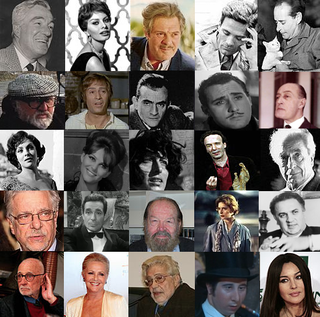
The cinema of Italy comprises the films made within Italy or by Italian directors. Italy is one of the birthplaces of art cinema and the stylistic aspect of film has been one of the most important factors in the history of Italian film. As of 2018, Italian films have won 14 Academy Awards for Best Foreign Language Film as well as 12 Palmes d'Or, one Academy Award for Best Picture and many Golden Lions and Golden Bears.
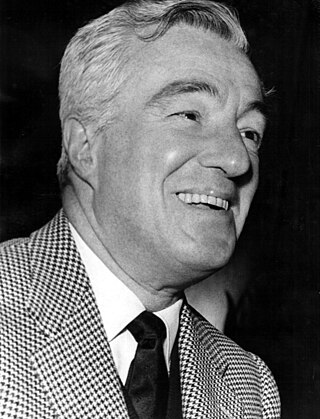
Vittorio De Sica was an Italian film director and actor, a leading figure in the neorealist movement.

Roberto Gastone Zeffiro Rossellini was an Italian film director, screenwriter and producer. He was one of the most prominent directors of the Italian neorealist cinema, contributing to the movement with films such as Rome, Open City (1945), Paisan (1946), and Germany, Year Zero (1948). He is also known for his films starring Ingrid Bergman, Stromboli (1950), Europe '51 (1952), Journey to Italy (1954), Fear (1954), and Joan of Arc at the Stake (1954).

Luchino Visconti di Modrone, Count of Lonate Pozzolo was an Italian filmmaker, theatre and opera director, and screenwriter. He was one of the fathers of cinematic neorealism, but later moved towards luxurious, sweeping epics dealing with themes of beauty, decadence, death, and European history, especially the decay of the nobility and the bourgeoisie. Critic Jonathan Jones wrote that “no one did as much to shape Italian cinema as Luchino Visconti.”

Cesare Zavattini was an Italian screenwriter and one of the first theorists and proponents of the Neorealist movement in Italian cinema.

Anna Maria Magnani was an Italian actress. She was known for her explosive acting and earthy, realistic portrayals of characters.

Silvana Mangano was an Italian film actress. She was one of a generation of thespians who arose from the neorealist movement, and went on to become a major female star, regarded as a sex symbol for the 1950s and '60s. She won the David di Donatello for Best Actress three times – for The Verona Trial (1963), The Witches (1967), and The Scientific Cardplayer (1973) – and the Nastro d'Argento for Best Actress twice.
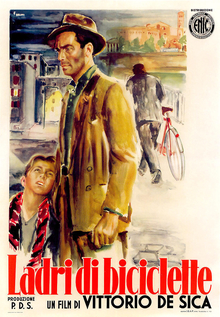
Bicycle Thieves, also known as The Bicycle Thief, is a 1948 Italian neorealist drama film directed by Vittorio De Sica. It follows the story of a poor father searching in post-World War II Rome for his stolen bicycle, without which he will lose the job which was to be the salvation of his young family.

Ossessione is a 1943 Italian crime drama film directed and co-written by Luchino Visconti, in his directorial debut. It is an unauthorized and uncredited adaptation of the 1934 novel The Postman Always Rings Twice by American author James M. Cain, and stars Clara Calamai, Massimo Girotti, and Juan de Landa in the leading roles. It is often considered to be the first Italian neorealist film, though there is some debate about whether such a categorization is accurate.
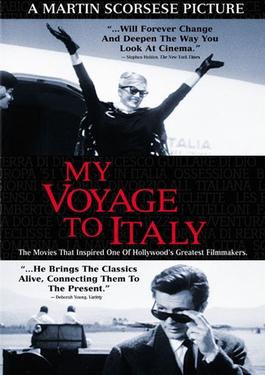
My Voyage to Italy is a personal documentary by acclaimed Italian-American director Martin Scorsese. The film is a voyage through Italian cinema history, marking influential films for Scorsese and particularly covering the Italian neorealism period.

Cinema of Europe refers to the film industries and films produced in the continent of Europe.

Telefoni Bianchi films, also called deco films, were made by the Italian film industry in the 1930s and the 1940s in imitation of American comedies of the time in a sharp contrast to the other important style of the era, calligrafismo, which was highly artistic. The cinema of Telefoni Bianchi was born from the success of the Italian film comedy of the early 1930s; it was a lighter version, cleansed of any intellectualism or veiled social criticism.
The Nastro d'Argento for Best Director is a film award bestowed annually as part of the Nastro d'Argento awards since 1946, organized by the Italian National Association of Film Journalists, the national association of Italian film critics.

Franco Interlenghi was an Italian actor.
Cineriz was an Italian film production and distribution company, founded in 1956 by the businessman Angelo Rizzoli. The company produced and/or distributed films by Federico Fellini, Gillo Pontecorvo, Luchino Visconti, Michelangelo Antonioni, Pier Paolo Pasolini, Pietro Germi, Roberto Rossellini, Vittorio De Sica and others. In 1993, Cineriz was incorporated into the RCS MediaGroup.
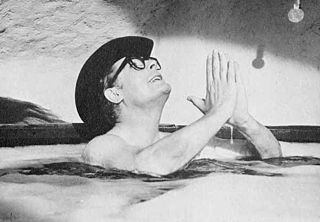
The list of the 100 Italian films to be saved was created with the aim to report "100 films that have changed the collective memory of the country between 1942 and 1978". Film preservation, or film restoration, describes a series of ongoing efforts among film historians, archivists, museums, cinematheques, and non-profit organizations to rescue decaying film stock and preserve the images they contain. In the widest sense, preservation assures that a movie will continue to exist in as close to its original form as possible.
Eraldo Da Roma was an Italian film editor best known for his work with Roberto Rossellini, Vittorio De Sica, and Michelangelo Antonioni.

Salvo D'Angelo was an Italian film producer. He also worked as an art director and production designer.
Filmic representations of women have developed in tandem with changing historical and socio-cultural influences. Italian neorealism was a movement that, through art and film, attempted to "[recover] the reality of Italy" for an Italian society that was disillusioned by the propaganda of fascism. Representations of women in this era were influenced heavily by the suffrage movement and changing socio-political awareness of gender rights. The tension of this transitional era created a spectrum of female representation in film, where female characters were written to acquiesce, or more commonly reject, the societal standards imposed on the women of the age. Italian neorealists, with their characteristic use of realism and thematic-driven narrative, used their medium to explore these established ideals of gender and produce a number of filmic representations of women.
























